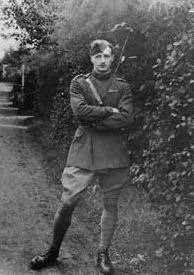William Leefe Robinson
William Leefe Robinson VC (born July 14, 1895 in Coorg , British India , † December 31, 1918 in Stanmore ) was a British fighter pilot of the First World War and the first pilot who managed to fly a German rigid airship over British territory shoot down. For this achievement he received the Victoria Cross .
biography
Robinson was born in Coorg, India in 1895 to owners of a coffee plantation. He received his education in England at the Dragon School in Oxford and at the St Bees School in the town of the same name .
When war broke out in August 1914 he went to the Royal Military Academy Sandhurst and was assigned to the Worcestershire Regiment in December of that year. In March 1915 he was transferred to the newly established Royal Flying Corps in France as an observer of a reconnaissance aircraft . After being wounded near Lille , he completed pilot training in England and was then assigned to the 39th squadron. This was stationed in Sutton Farm near Hornchurch and was used for night hunting to counteract the bombing by German airships.
On the night of September 2nd to 3rd, 1916, Robinson flew a BE2 night fighter and sighted the Schütte-Lanz SL-11 airship . Robinson approached the airship from below at 11,500 feet and approached 500 feet before opening fire. The airship caught fire and crashed near Cuffley , killing the 16-man crew. The shooting down was a propaganda success, because it demonstrated the vulnerability of airships against the then hardly developed fighters. Robinson was awarded the Victoria Cross , the highest order of military bravery, for being shot down.
As early as June 1915, Reginald Alexander John Warneford had managed to shoot down the Zeppelin LZ37 over Ghent, Belgium. However, bombs thrown from above on the zeppelin were used for this, while Robinson used machine guns. In addition, the subsequent explosion damaged Warneford's aircraft significantly, so that the pilot was forced to make an emergency landing on enemy territory and a temporary repair.
In April 1917 Robinson was assigned to the rank of flight commander of Squadron 48 RFC and moved to France. During his first patrol on April 5, 1917, Robinson's unit got into a battle with Jasta 11 aircraft under Manfred von Richthofen . Squadron 48 lost four of its six Bristol F.2 aircraft , including the one with Robinson on board, which was shot down by Sebastian Festner . Robinson himself was wounded and taken prisoner. He spent his captivity in Holzminden and in Zorndorf . After several attempts to escape, he was finally taken into solitary confinement, and his health deteriorated steadily.
On his return after the end of the war he fell ill with the Spanish flu and died on December 31, 1918 in his sister's house in Stanmore . His grave is in the graveyard of All Saints' Church in Harrow Weald . A memorial was erected to him in Cuffley, where the airship he shot down crashed. Another plaque is in East Ridgeway; further on the street "Robinson Close" in Hornchurch is named after him. With £ 98,000 from auctioning his awards and other memorabilia, a charity fund was set up in 1986 to help children with leukemia .
literature
- Arch Whitehouse: Aviator Aces 1914-1918 . Motorbuch-Verlag, Stuttgart 1970, pp. 283-284.
Web links
- Kurzbiografie (English)
Individual evidence
- ^ Leslie Bills: Robinson VC , in Airplane Monthly October 1996, p. 68
| personal data | |
|---|---|
| SURNAME | Robinson, William Leefe |
| ALTERNATIVE NAMES | Robinson, Leefe |
| BRIEF DESCRIPTION | British military pilot in World War I. |
| DATE OF BIRTH | July 14, 1895 |
| PLACE OF BIRTH | Coorg , British India |
| DATE OF DEATH | December 31, 1918 |
| Place of death | Stanmore (London) , Middlesex |
